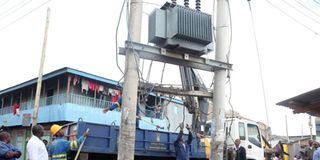Premium
Kenya Power to meter transformers

Kenya Power officials disconnect electricity from a transformer at Imara Daima estate in Nairobi in June in a crackdown on illegal connections.
What you need to know:
- Kenya Power MD Bernard Ngugi said the move will reduce and eventually wipe out electricity theft via illegal connections as it will be possible to trace the source of the power being illegally consumed.
- The company is said to be tightening controls about its processes to keep away crooks who work with insiders to run illegal power connection empire.
Kenya Power has initiated talks with financiers to fund the metering of all its transformers to track electricity system loss through theft and transmission that costs the monopoly over Sh18 billion per year.
The firm said it had begun engaging financiers to bankroll the initiative starting from Nairobi where power theft hotspots have been mapped before rolling the project across the country.
Each meter is likely to cost about Sh70,000 given the estimate that Nairobi’s 10,000 transformers will be metered at approximately Sh700 million. This makes exercise across the country where there are close to 70,000 transformers, a multi-billion shilling venture.
Kenya Power Managing Director Bernard Ngugi said the move will reduce and eventually wipe out electricity theft via illegal connections as it will be possible to trace the source of the power being illegally consumed.
“We are in talks with financiers to meter all transformers to address the losses whereby we will be comparing the power leaving each transformer with the meter readings from all the customers that draw electricity from a particular transformer then we can tell exactly where we are losing the power. When all transformers are metered, we can reduce the commercial loss to zero,” Mr Ngugi said.
Gadget tampering
While technical losses occur when electrical energy is dissipated in the process of transmission and distribution commercial losses are mainly attributed to pilferages, faulty meters and gadget tampering.
Mr Ngugi said commercial losses now account for 11 percent of power losses with the other 13 percent attributed to technical causes due to inefficiencies.
The plan will start from Nairobi where the bulk of Kenya power customers are based and where there have been massive losses from illegal connections. Kisii is also said to be a major hotspot for illegal connection.
The company is said to be tightening controls about its processes to keep away crooks who work with insiders to run illegal power connection empire.
Over 100 staff have been sacked for being involved in the backdoor power supply where applicants are targeted given lower offers to have their homes and business connected using stolen poles and conductors from other lines or Kenya power stores.
A metered transformer will reveal those benefiting from stolen electricity, which has pushed Kenya Power losses to 23 percent, way above the allowable level of 14.9 percent. The extra loss then becomes a cost to the company.
As at end of June 2018, the grid was being served by some 67,352 distribution transformers spread across the over 200,000 kilometres of distribution lines in the country.
The massive network and high number of transformers, which are not metered, has made it difficult for Kenya Power to tell specific areas where losses come from.
The firm will also be procuring boundary meters to account for electricity sales in every region under the new devolved management structure set to organise counties as profit centres.
Lost power makes one of the biggest set-backs for the power distributor who is regulated on how much power to buy from generators such as Kenya Electricity Generating Company (KenGen) and for how much it can sell the energy to customers.
Tariff review
The utility service provider has been pushing for a tariff review to see it through revenue headwinds which has seen it announce a third profit warning in a row and scaled down capital intensive ventures such as prepaid metering.
Mr Ngugi said there are ongoing upgrades to improve the distribution network and reduce technical losses. The improvements include building of substations and automation of lines to improve supply and sell more electricity to consumers.
“We are building substations to reduce technical losses as we invest in system automation to detect where faults are and make remote interventions including switching off to avert damage. The Scada system will help us dispatch power based on source and cost merit. The live maintenance team also ensures people are powered when we are carrying out maintenance and use the additional switch gears, we have sourced to select areas where we can switch off without affecting large areas during maintenance works,” Mr Mgugi said.
The company has grown its network in the recent past driven by the government plans to achieve universal connectivity and led to a consequent increase in system losses.
Vandalism has also been a huge loss for the firm as crooks target transformers and copper wires for sale, cutting off supply and increasing maintenance and surveillance cost for the lines.





